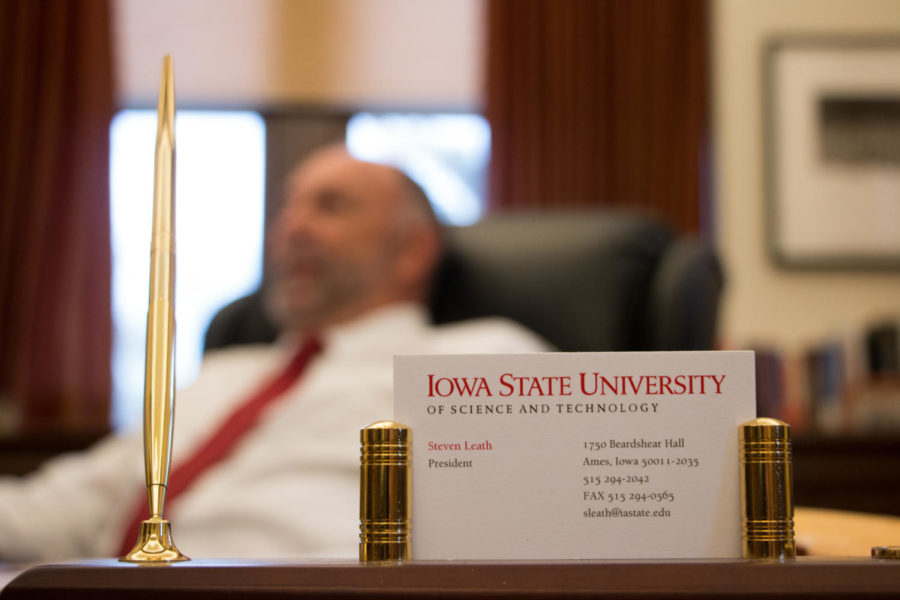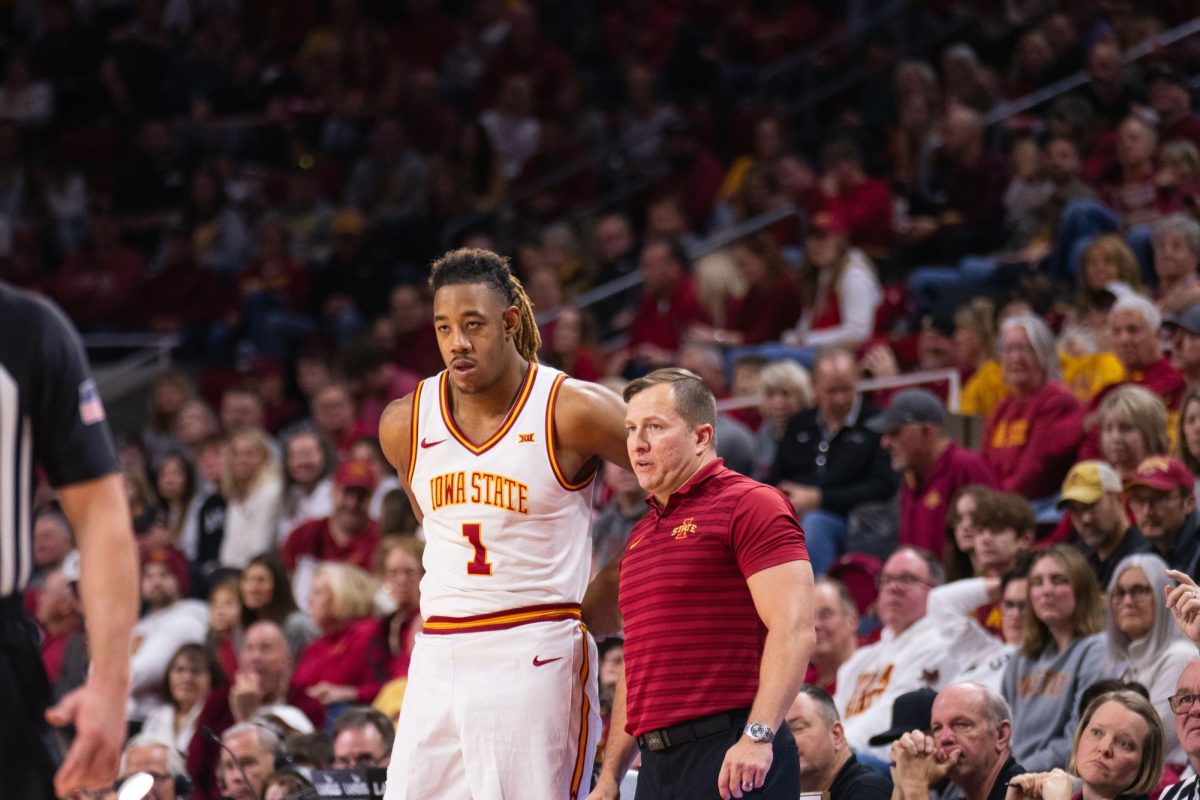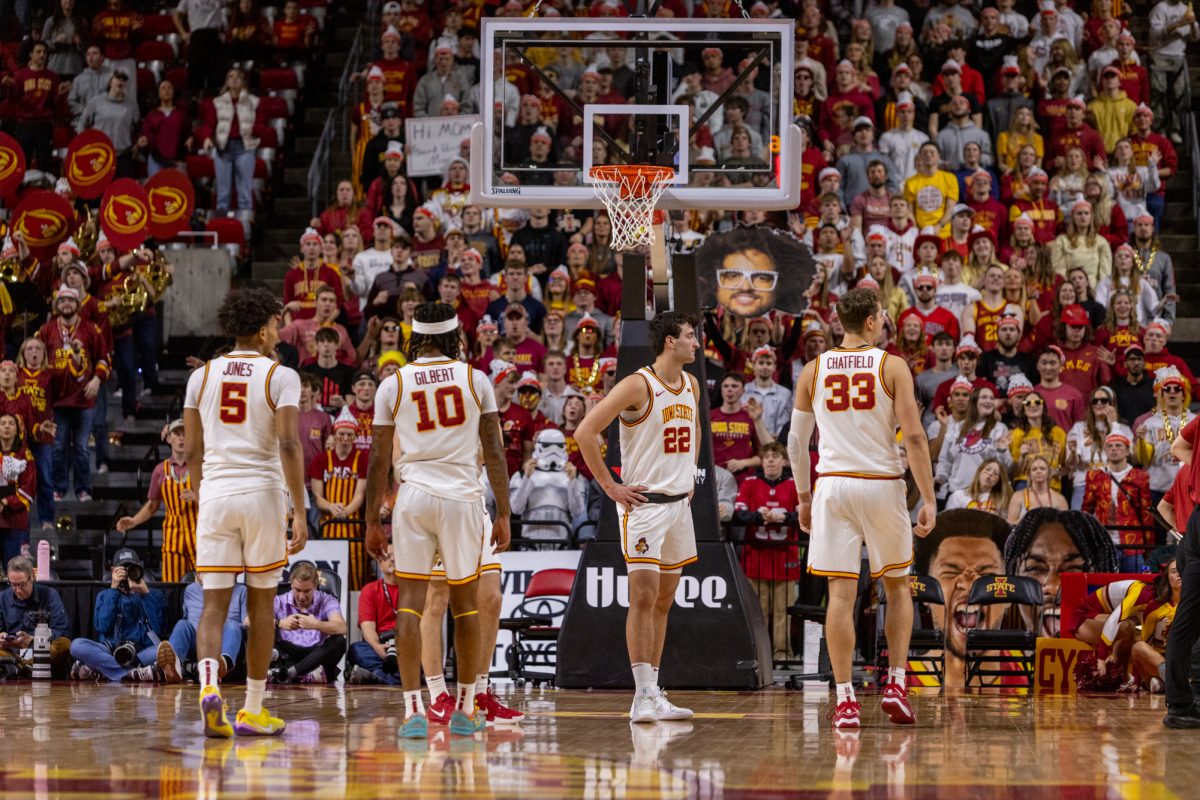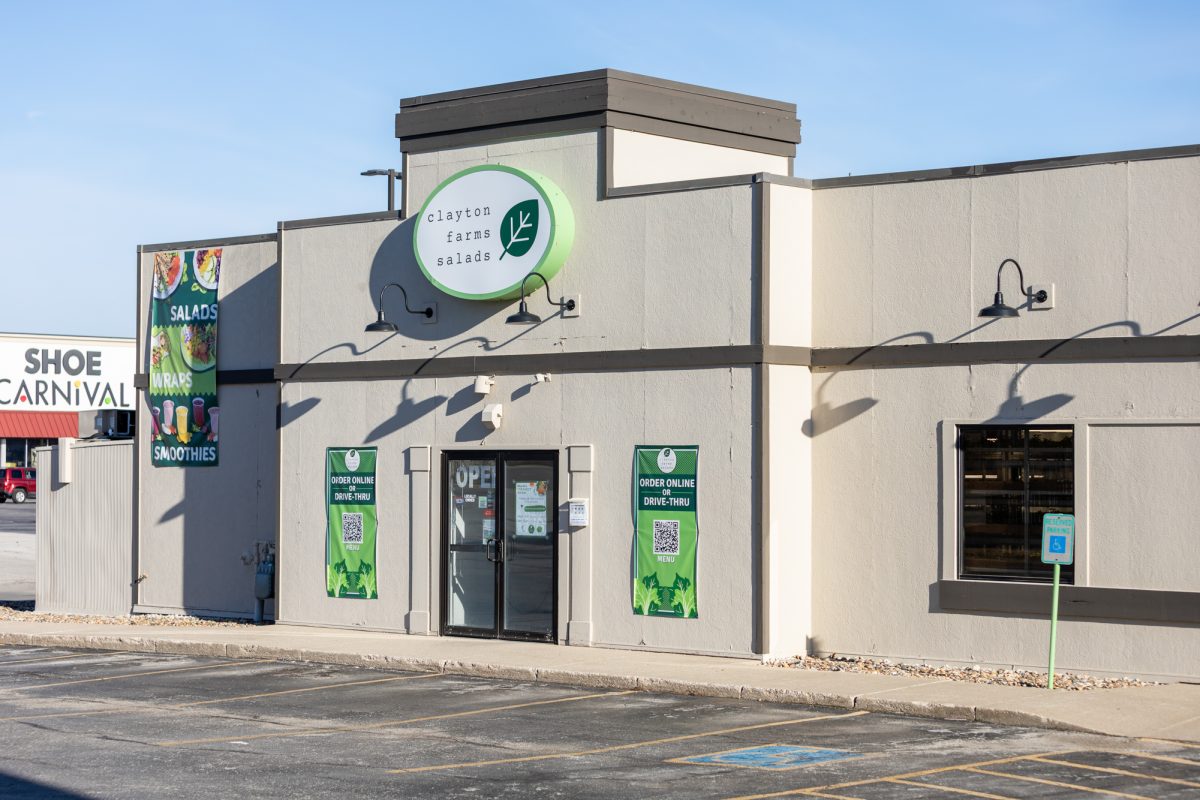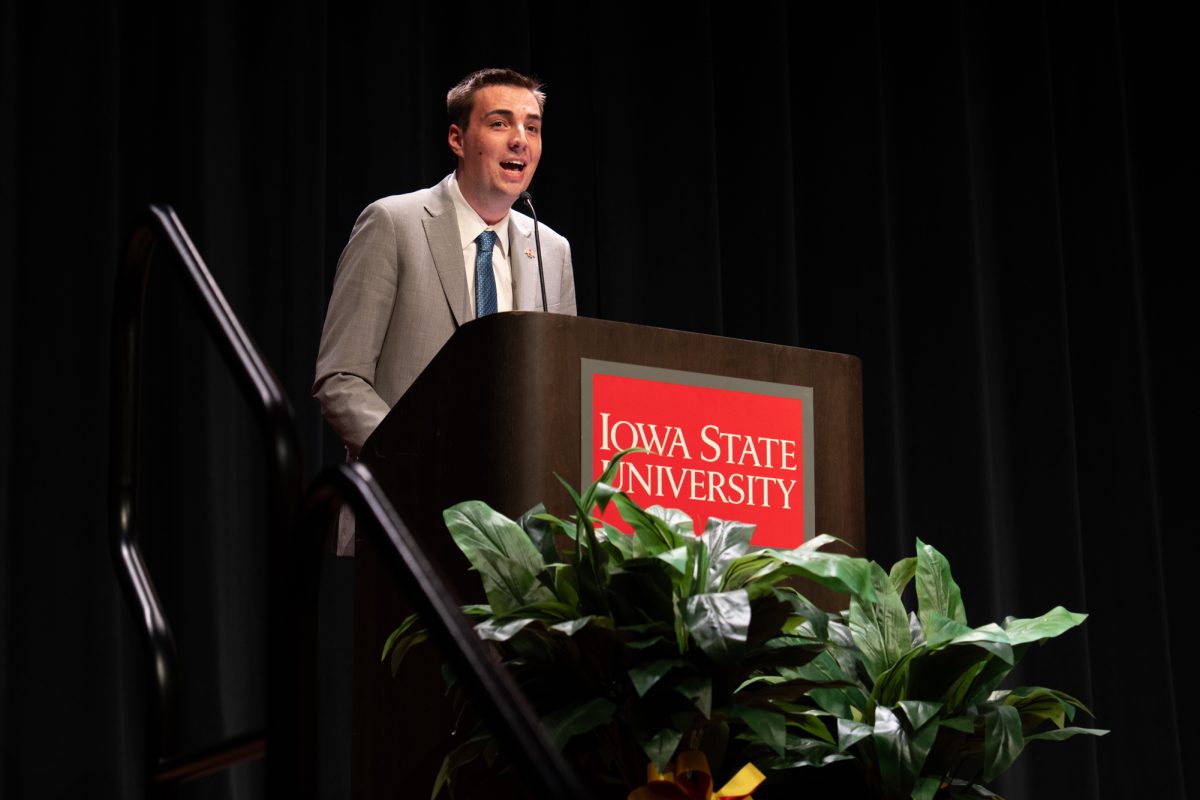- App Content
- App Content / News
- News
- News / Academics
- News / Politics And Administration
- News / Student Life
Small windows of time: A day in the life of a university president
January 12, 2017
Steven Leath began his presidency with a promise to work tirelessly to become the citizen and servant the community expects him to be.
It’s late September 2011, and the then-president-elect is standing in front of the windows in the Campanile Room of the Memorial Union. His wife, Janet, stands at his side.
He says he is both honored and excited to join the Iowa State family. Then-Iowa Board of Regents President Craig Lang said the board was looking for an individual with a vision for the university and the state of Iowa itself.
Leath, who was formerly the vice president of research at the University of North Carolina at Chapel Hill, had been selected by a unanimous vote.
He fit the bill.
And when it was announced that Leath would be the 15th president of Iowa State University the room erupted in applause. He said he believed in the future of public universities, the branding of Iowa State, the value of a Cyclone education.
From that day on, Leath would live for Iowa State — and with a smile, too.
But Leath’s tenure has not been without rift.
Iowa State, like most universities, is a place of social uneasiness. It is a community diverse of thought, but not always inclusive. Leath is right in the middle of it — to some he is the problem; to others he is the solution.
Recent controversies surrounding the president have plagued Leath and the university.
But no one said the role of the president is easy. It is not without flaw.
As his fifth year at Iowa State approaches, here’s a look inside a day in the life of President Leath.
MORNING
In the back seat of Leath’s red Ford Explorer lies a red folder. It contains his perfectly crafted schedule, pre-written remarks and other essentials to help him get through his multitude of meetings, events and other interactions.
It’s a crisp, early November morning. Leath usually begins his days at 6:15 a.m., which he says is subject to change based on the time he went to bed the night before.
By 7:45 a.m. he is out the door. His first stop is the Core Facility at the Research Park for a meet-and-greet with several provosts from other Big 12 universities.
The Research Park — an innovation community and incubator for expanding business — is something Leath has worked to continually expand. The Park was established in 1987 as a not-for-profit. It has been a hub for start-up companies and entrepreneurial ventures.
When discussing the Research Park, Leath’s face lights up. He always has one more fact to share, one more detail to note in regard to what he refers to as the prosperous and growing community of the park.
Turning onto Lincoln Way, his hands grip the steering wheel. He puts on his sunglasses and remarks on how much Iowa State has changed. To him, the campus is evolving.
He mentions that the university is going to purchase more land for the Park — 68.38 acres. He’s excited for the upward movement.
Grabbing a cup of coffee before the Big 12 meeting, Leath works his way around the second-floor conference room of the Core Facility. He is sure to say hello to everyone and makes an effort to make them feel welcomed.
He takes a seat at the front of the table and sets his note cards out in front of him. He shifts with his hands and stares ahead, waiting for the room to settle, a blank look crosses his face.
“We have been fairly successful,” Leath says to the room. “I don’t want to say hugely successful because you always want to do better, but we have had increases in funding from the state every year I’ve been here.
“A lot of schools probably can’t say that over the last five years or so.”
The provosts are looking to him to answer their questions, which are largely based on concerns they are experiencing on their own college campuses.
Leath, however, is ready to cover any topic. From state funding and tuition to fundraising and research. He’s committed to knowing more about Iowa State — both about what works and what doesn’t.
“A lot of our issues are similar, things that we can all share ideas on, and I think we’ll be stronger if we worked together,” Leath says, addressing their goal of what he described as high quality, accessible and affordable public education.
Leath touched on the $1.1 billion fundraising campaign the university launched during the 2016 fall semester.
“I think the job of the president has changed a lot, and just to give you a little feel of how we do things here, we’re in the middle of a capital campaign,” Leath said. “And I have to raise about $405,000 a day, seven days a week for the next 4.5 years.”
The capital campaign, which is the largest fundraising initiative in the history of the university, is called the “Forever True, For Iowa State,” and the money raised will rally support for scholarships, faculty support, facilities and programs.
After roughly 15 minutes with the provosts, Leath is on to his next appointment — taping a video on a financial literacy module Iowa State is expecting to launch.
This is preceded, however, by a stop at the dry cleaners to drop off some dirty laundry and pick up some clean clothes. For Leath, it’s a small window of time when he can fulfill any personal obligations he may have.
Still sipping on the cup of coffee he grabbed at the Core Facility, Leath begins a stroll across campus, starting at the Knoll and making his way down Osborn Drive to Morrill Road. Several students notice the university’s president and give a small wave. He smiles back.
You’d be hard-pressed to find a student who doesn’t recognize Leath. He jokes that the last Iowa State president to have a beard, a more notable feature of the president, was William Beardshear. He notes that Beardshear was also the only president to die while serving in the position.
When students see him walking around campus they say hello, but most act uncomfortable, Leath says, as they are not exactly sure what they want to, or should, say to him.
More often than not, Leath is asked to take a selfie. As a 21st century president, Leath, whose role is to serve a generation of millennials, obliges.
This is not the only way Leath serves the students, however.
On top of getting to know students, meeting with fellow administrators and being an active part of the Iowa State community, Leath is active on several boards, works with donors to raise funds for the ISU Foundation and, most importantly, is a husband to his wife Janet and a father to his two sons.
“[It’s my] obligation as president to know what’s going on,” he adds.
Leath is a man who holds onto words, whether they’re great, good, bad or ugly.
He mentions a memory that has stuck with him since first arriving at the university five years ago. An opinion writer at the Iowa State Daily had run into Leath while on campus and described him as friendly and outgoing.
“The person said I was approachable,” Leath said. “It stuck with me.”
But Leath is not always lucky enough to have positive interactions. As of late, students, community members and news outlets have become critical of Leath, questioning his commitment and rationale, a trend best described as a growing distrust.
One of the more recent controversies surrounding Leath includes what has been dubbed by many as “planegate,” referring to the possible misuse of university-owned aircraft by Leath.
Leath had been involved in a hard landing in July 2015, causing nearly $14,000 in damages, which had been kept largely under wraps by Leath and the university. Leath has paid back the damages, and more, in full.
However, during a December Board of Regents meeting, the regents found Leath did not break any existing board policy.
Walking into his office after the trek across campus, Leath notes to his assistant, Shirley Knipfel, that he won’t have time to check his email before taping the financial literacy video.
Leath said he typically tries to carve out several hours of his day to answer emails and catch up on phone calls, but if his day is too packed — as it often is — the university president works from his office in the Knoll until 8 p.m. each night.
On this particular day, even as early as 9 a.m., Leath estimated that his work day would end like that.
Sitting at his desk, Leath reviews the script for the financial literacy module, joking continuously throughout the preparation.
He fidgets with a top at his desk, spinning it as he takes note of all the things happening around him. The top is cardinal and gold – Cyclone colors.
Also on his desk sits two small scientists, Sir Isaac Newton and Albert Einstein. He puts Einstein in front of him while he continues to wait to tape the video. It’s a small joke to himself, and he moves it when filming begins.
Leath is different from other university presidents in that his roots come from research and science. He holds a bachelor’s degree in plant science from Pennsylvania State University, a master’s degree in plant science from the University of Delaware and a doctorate in plant pathology from the University of Illinois.
As mid-morning approaches, Leath gears up for a meeting with ISU Dining Director Mohammed Ali, Dean of College of Agriculture and Life Sciences Wendy Wintersteen and Senior Vice President for Student Affairs Martino Harmon.
The four are discussing the possibility of a creamery – using Iowa State resources to produce a branded university ice cream.
Supportive of the idea, Leath said he was surprised that Iowa State didn’t already have one when he first came here. He takes off his suit jacket for the meeting, because he is finally going to be able to settle into his office for the next several hours.
Everything about Leath’s attire embodies Iowa State, from his red cuff links to his red tie with the university logo decaled on it.
In meeting with Harmon, Ali and Wintersteen, Leath allows the three to lead the discussion, throwing in ideas where they fit but also remaining a sounding board for what the university can actually take on.
He remains precise and to the point throughout the meeting, controlling it so that it stays successful yet comfortable.
“So what do you need?” Leath asks, optimistic of the opportunities that lie ahead.
AFTERNOON
After a morning packed with meetings and filming, Leath heads over to his desk. A large computer monitor sits to the side of him. Finally, he says, he has time to check his email.
In the midst of filming the financial literacy video, a community-wide video pre-recorded by Leath had been sent out to the Iowa State community. The video is touching on the election and current climate at the university.
The video particularly touches on the “white heritage” posters discovered on campus in late October. He asks that anyone “who feels their race, ethnicity, gender, sexual orientation, religion or political views makes them superior to others is encouraged to find another institution that aligns with their values.
“As Iowa Staters, we must prevail over racism, discrimination and bigotry by opening our minds and hearts to each other. We know our campus is far from perfect, but we can improve if we commit ourselves to the principles of the Iowa State Community.”
The emails to Leath soon begin to flood in — some negative, but the majority positive.
No matter the response, however, he takes neither reaction lightly.
He says it can be frustrating as a president to see a lack of polite discourse, almost bothersome.
A group of students wave at Leath as he walks past them outside of Seasons Marketplace, a dining center on campus. It’s time for lunch and he’s getting his favorite food — Italian.
Decorating a plate with some pasta, bread and salad, Leath settles in at a table near the windows of the dining center.
Several Iowa State basketball players are sitting only a few feet away. He waves to them as they are about to leave.
“You did good,” Leath says to Simeon Carter, a forward on the basketball team. Carter towers over Leath as he remains seated in his chair, the two exchanging casual remarks.
Leath says that part of what he enjoys about being the university president is that he gets to meet people from all walks of life. Every day he gets to learn something new.
“[It’s] something different every day,” he says.
Finishing his lunch, Leath shoots his wife a text. The two are meeting later in the day to attend the Gold Star Hall Ceremony and to visit community advisers in Helser Hall.
The two met each other while Leath was a graduate student at the University of Delaware and Janet was pursuing her undergraduate degree. Janet is older than Leath by two years, however, because she started schooling later.
The Leaths have two children — Eric and Scott, one who lives in Ames and another who lives in North Carolina, where the Leath family formerly lived for 27 years.
“1:00 at Geoffrey Hall?” Leath texts Janet.
As the first lady of the university, Janet works closely with University Museums and women in philanthropy. She also attends the gym three days a week and works with a student trainer.
She declines. They’ll see each other later.
Gregory L. Geoffroy Hall, the newest residence hall to join the ranks at Iowa State, has been in the works for several years.
The residence hall will hopefully ease some of the growing pains of the university, as it exceeded, once again, the most number of students Iowa State has ever had. The fall semester hit a record-breaking number of 36,660 students.
On this particular day, Leath is touring the new residence hall. He said he has only been in it one other time, despite living directly across from it.
Walking on the main floor of the building, Leath is excited for Geoffroy Hall, growing more and more curious as he peeks in and out of the dorm rooms.
On the eighth floor of the residence hall, Leath stares out one of the windows facing campus. He’s seeing parts of Iowa State before that he’s never seen — a view that Geoffroy Hall students will have the opportunity to see every day.
LATE AFTERNOON
With no more administrative meetings left on the agenda for Leath, he heads back into his office for a little downtime.
On his way to his Beardshear office, he chats with two visiting families, proposing to them why Iowa State, to him, is truly the greatest.
“Brandon and Parker are ascending to greater heights,” Leath jokes about the two prospective students, as their parents had attended the University of Iowa and the University of Northern Iowa.
“I’m glad you’re here.”
Leath said that whenever there is orientation or tours in Beardshear, he tries to visit with one or two families.
“You want to see if are they confused. Are they happy? Was it a good tour, bad tour?” Leath says.
“So I try and just ask them. They seem to have a good tour.”
Driving in his red Ford Explorer, Leath is headed for his last scheduled event of the day — a visit with Helser Hall community advisers.
First he has to pick up Janet, however, because she had stopped by the Knoll to let out their two dogs, Quill and Dixie.
The two are running late, and Janet gives Leath a call as he is pulling into the driveway.
“You are coming to get me, right?” Janet asks. He laughs.
Pulling into the Union Drive Community Center, the Leaths’ next task is to find parking — a meter will suffice.
He is met by Kwizera Imani, a former student in Leath’s freshman leadership class. The 11 students meeting with the Leaths are expressing their concerns, along with sharing their ideas about where and how Iowa State can and should improve.
One of the students’ biggest concerns includes not having a sufficient amount of free, safe weekend activities.
The Leaths and the students begin to brainstorm a way in which this problem can have a possible, if not permanent, solution.
And with that, his day is done.
He will go home, catch up on email and repeat it all.
Because for Leath, it’s just a day in his life.


